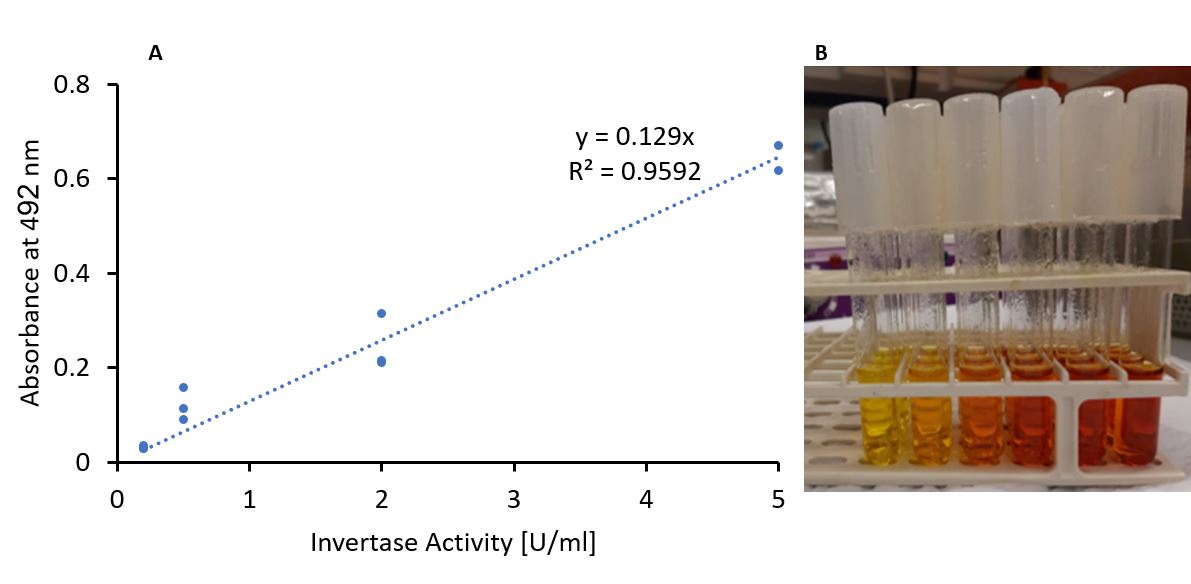Difference between revisions of "Part:BBa K2934001"
(→References) |
(→Methods) |
||
| Line 50: | Line 50: | ||
<partinfo>BBa_K2934001 parameters</partinfo> | <partinfo>BBa_K2934001 parameters</partinfo> | ||
<!-- --> | <!-- --> | ||
| + | |||
| + | ===References=== | ||
| + | [1] Nadeem H, Rashid MH, Siddique MH, Azeem F, Muzammil S, Javed MR, Ali MA, Rasul I, Riaz M. 2015. Microbial invertases: A review on kinetics, thermodynamics, physiochemical properties. Process Biochem 50:1202–1210. | ||
| + | |||
| + | [2] Persano Oddo L, Piazza MG, Pulcini P. 1999. Invertase activity in honey. Apidologie 30:57–65. | ||
| + | |||
| + | [3] L’Hocine L, Wang Z, Jiang B, Xu S. 2000. Purification and partial characterization of fructosyltransferase and invertase from <em>Aspergillus niger</em> AS0023. J Biotechnol 81:73–84. | ||
| + | |||
| + | [4] Goosen C, Yuan XL, Van Munster JM, Ram AFJ, Van Der Maarel MJEC, Dijkhuizen L. 2007. Molecular and biochemical characterization of a novel intracellular invertase from <em>Aspergillus nigerm> with transfructosylating activity. Eukaryot Cell 6:674–681. | ||
Revision as of 15:52, 21 October 2019
Invertase-Histag A. niger optimized for B. subtilis
Codes for the invertase enzyme, originally from A. niger and codon-optimized for B. subtilis. The invertase enzyme catalyzes the degradation of sucrose to glucose and fructose. The sequence includes His-tag (6xHis), connected with seven amino acids linker at the C-terminus of the protein, for simple protein purification.
Usage and Biology
Invertase is an enzyme that catalyzes the cleavage of sucrose into fructose and glucose. Since cleaving the sucrose is the very first step in the creation of honey, we have chosen to use a variation of invertase that is reported to be highly active, which originates from the mold species Aspergillus niger [1]. This type of invertase has been widely investigated and is known to be relatively stable [2]. This invertase works as a dimer [3], each monomer the size of 75 kDa (4) and its optimal pH and temperature are 5 and 60⁰C respectively [3].
Sequence and Features
- 10COMPATIBLE WITH RFC[10]
- 12COMPATIBLE WITH RFC[12]
- 21INCOMPATIBLE WITH RFC[21]Illegal BglII site found at 863
- 23COMPATIBLE WITH RFC[23]
- 25INCOMPATIBLE WITH RFC[25]Illegal AgeI site found at 1168
- 1000INCOMPATIBLE WITH RFC[1000]Illegal BsaI.rc site found at 469
Illegal BsaI.rc site found at 811
Illegal SapI.rc site found at 1071
Invertase Activity Assay
Invertase is an enzyme that cleaves sucrose to form glucose and fructose. Thus, a precise method that will detect either glucose or fructose can indicate the amount of sucrose cleaved by the enzyme. The test we used is based on the "reducing sugars" assay, in which reducing sugars react with the yellow picric acid to form picramic acid, which is red (Figure 2). Therefore, the absorbance of red light (492nm) could indicate the amount of sucrose cleaved, which indicates the enzymatic activity.
To verify that the activity-absorbance correlation remains linear under the experiment is conditions, we performed the experiment using a commercial enzyme, creating a calibration curve. We used increasing concentrations of commercial invertase (with a well-determined specific activity) and a constant saturated concentration of sucrose. Then, we checked the 492 nm light absorbance and plotted the calibration curve (Figure 3).
After the cloning process had been completed, we performed an activity test on the bacterial invertase. We tested both bacterial lysate and bacterial supernatant to determine whether active invertase had been produced and secreted by evaluating the activity in each sample. The recombinant bacteria samples were compared to wild type (WT) samples.
The first colony tested contained the invertase enzyme with AmyE as a signal peptide (BBa_K2273023). Unfortunately, no notable activity was detected (Figure 4).
These results, in addition to the results observed in the SDS-PAGE experiment, indicating that the AmyE signal peptide may interfere with either the enzyme's production or its activity.
In addition to evaluating the activity of invertase with AmyE, we used a library of signal peptides aiming to obtain enzymatic activity for the bacterial invertase (Figure 5). The Bacterial supernatant activity detected is 0.18U/ml and the activity detected in the lysate solution is 0.12U/ml. The activity detected for the WT sample is observed to be significantly lower in comparison to the bacterial samples, both in the supernatant and the lysate, i.e, one or more of the library signal peptides has enabled both secretion and activity of the enzyme.
Methods
This vector was constructed by Gibson assembly, with the pBE-S commercial plasmid (Takara) that served as a backbone, and eventually transformed into Bacillus subtilis (RIK1285).
The bacteria were cultured over-night at 37°C in a shaking incubator (250 rpm), followed by 1:100 dilution. The diluted culture was incubated for another few hours while monitoring the culture turbidity by measuring the O.D600.
When the culture has reached the logarithmic growth phase, the bacterial extracellular and intracellular proteins were separated, after collecting the supernatant and the pellet (followed by lysis, using sonicator).
For further reading of our full protocols (cloning, enzymatic assays and enzymatic assay under different pH levels) look at our wiki protocols page.
References
[1] Nadeem H, Rashid MH, Siddique MH, Azeem F, Muzammil S, Javed MR, Ali MA, Rasul I, Riaz M. 2015. Microbial invertases: A review on kinetics, thermodynamics, physiochemical properties. Process Biochem 50:1202–1210.
[2] Persano Oddo L, Piazza MG, Pulcini P. 1999. Invertase activity in honey. Apidologie 30:57–65.
[3] L’Hocine L, Wang Z, Jiang B, Xu S. 2000. Purification and partial characterization of fructosyltransferase and invertase from Aspergillus niger AS0023. J Biotechnol 81:73–84.
[4] Goosen C, Yuan XL, Van Munster JM, Ram AFJ, Van Der Maarel MJEC, Dijkhuizen L. 2007. Molecular and biochemical characterization of a novel intracellular invertase from Aspergillus nigerm> with transfructosylating activity. Eukaryot Cell 6:674–681.





